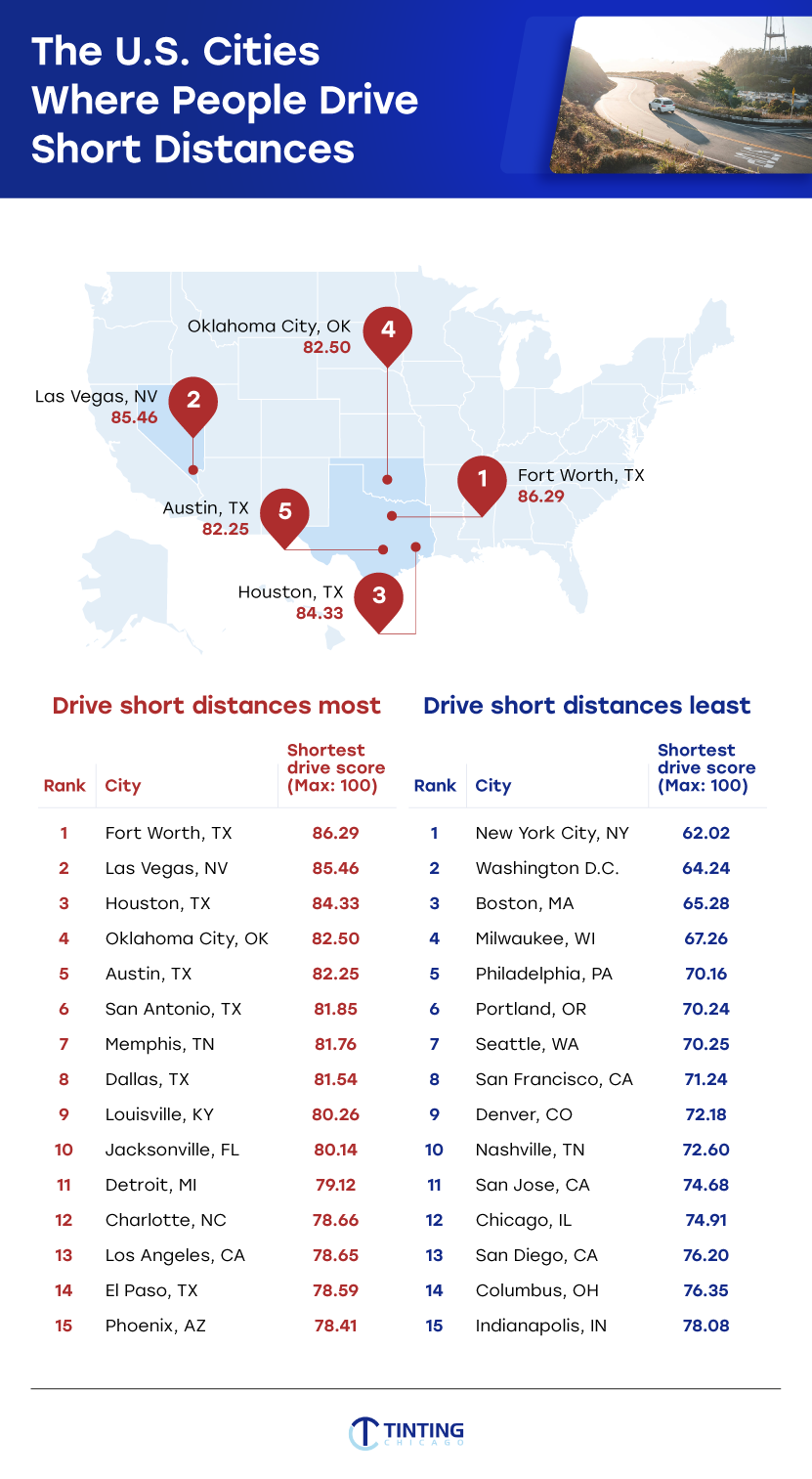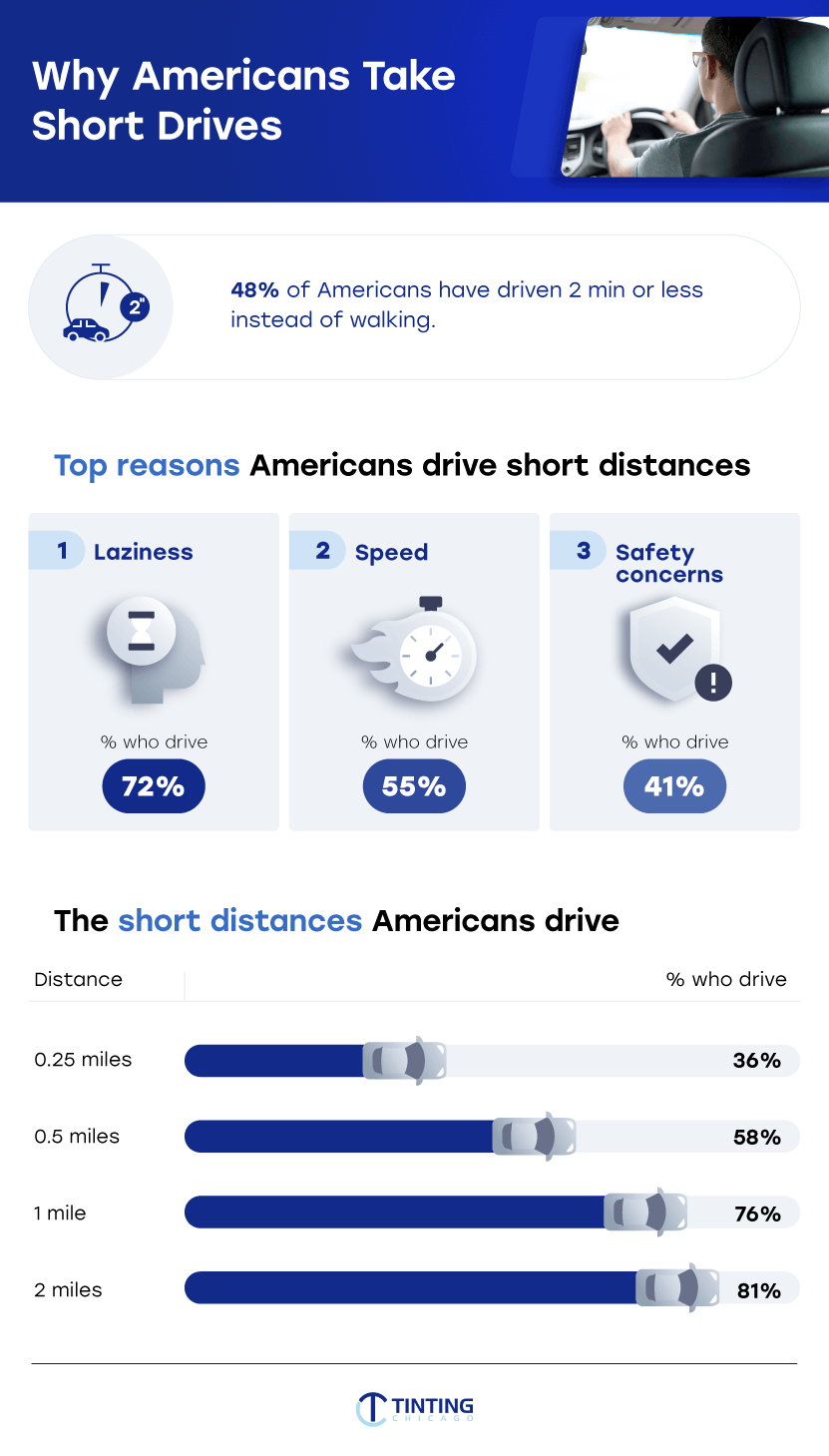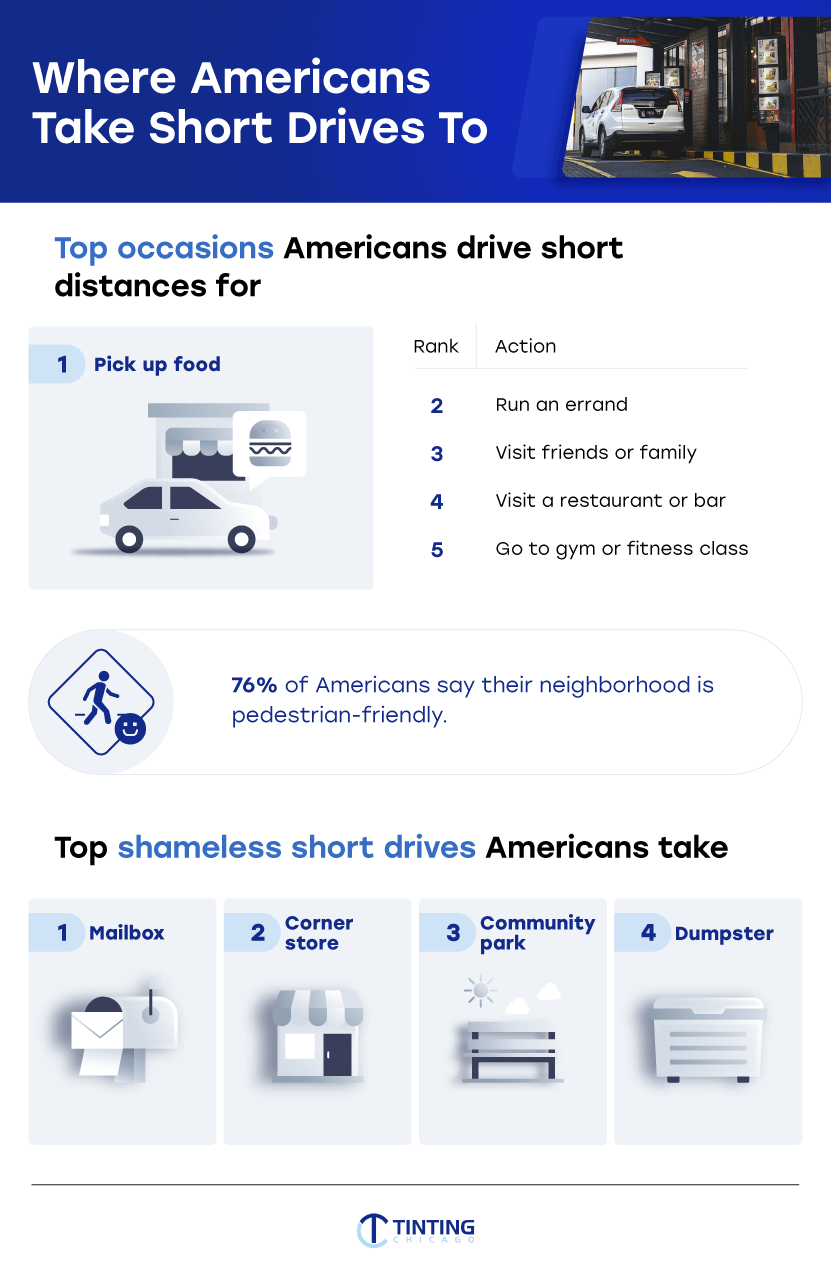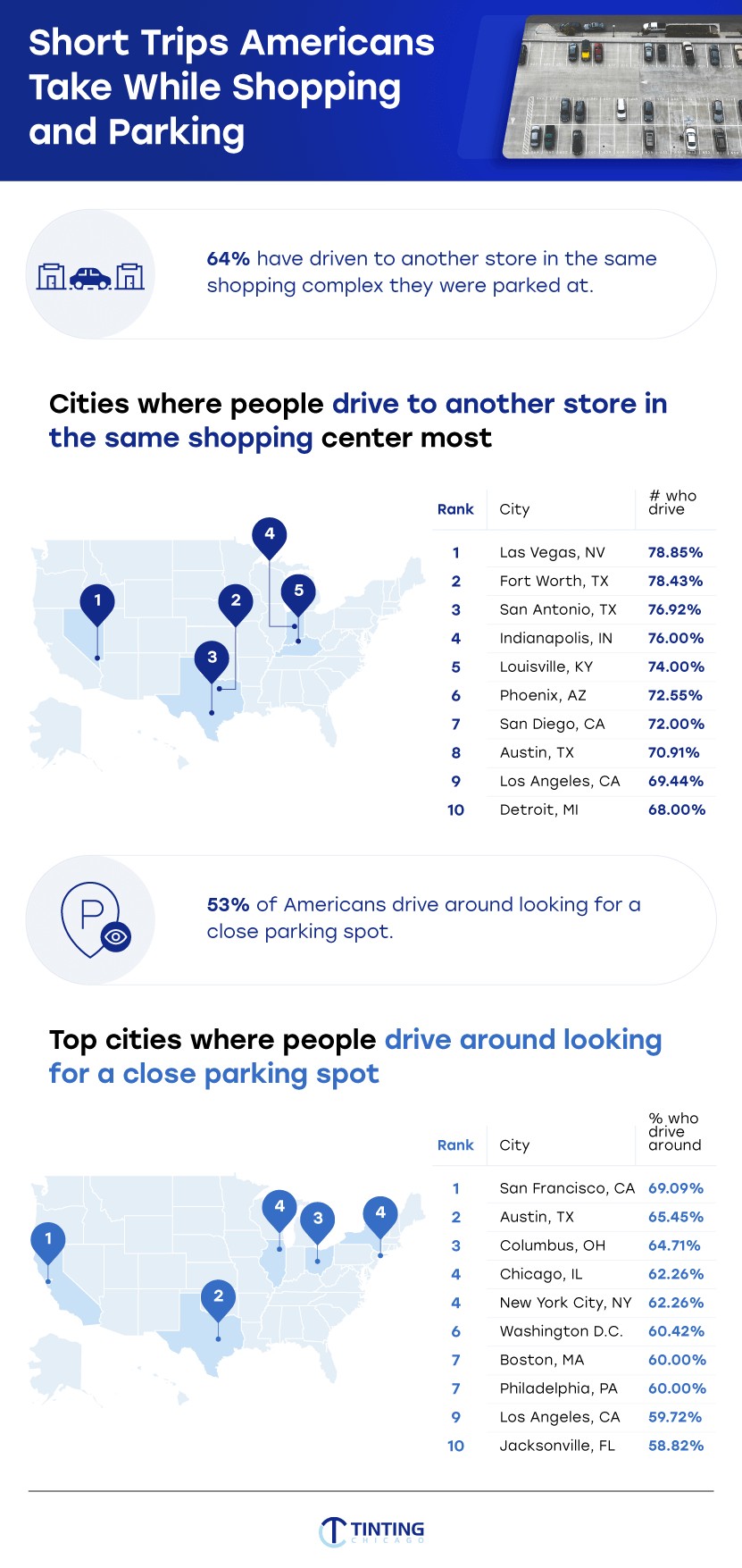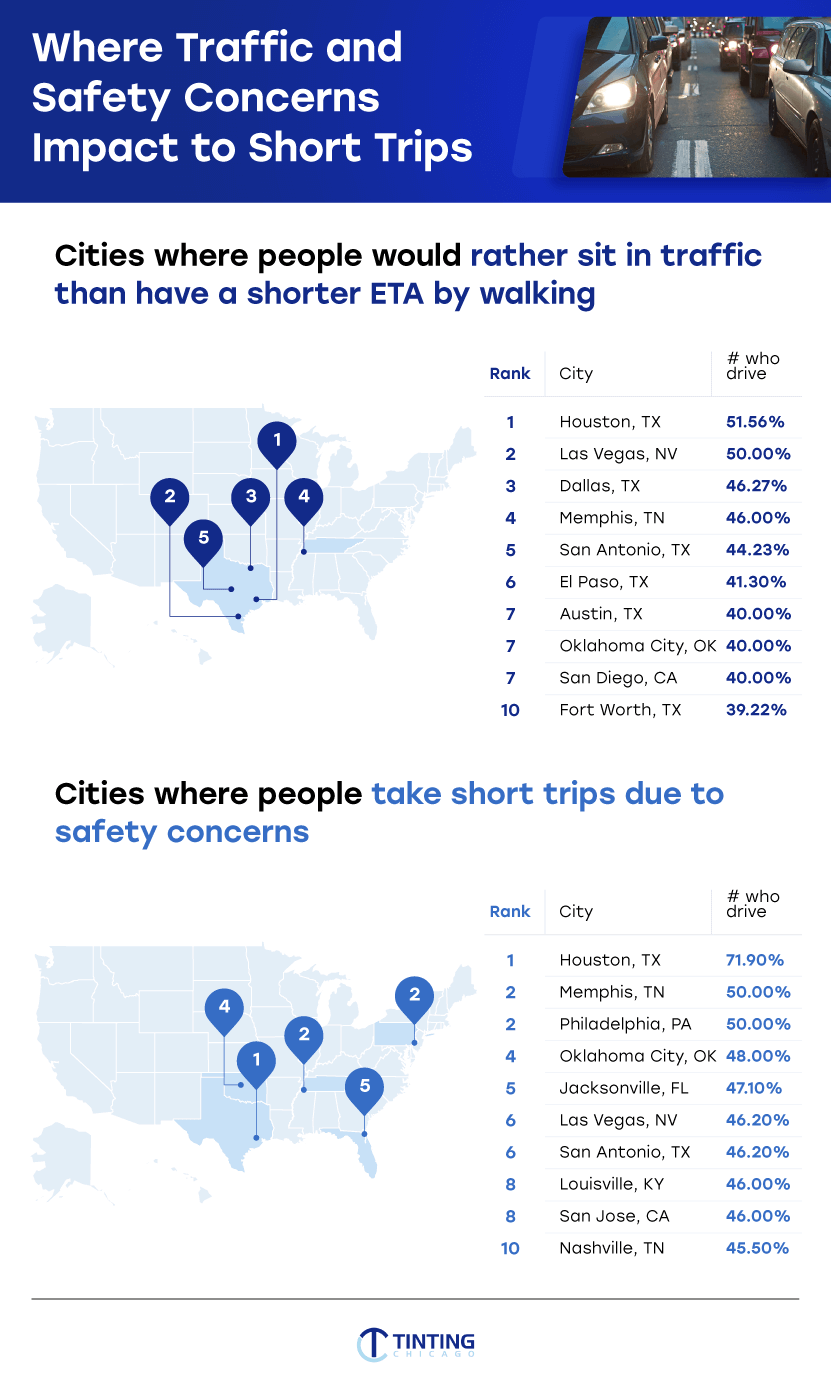



































































































































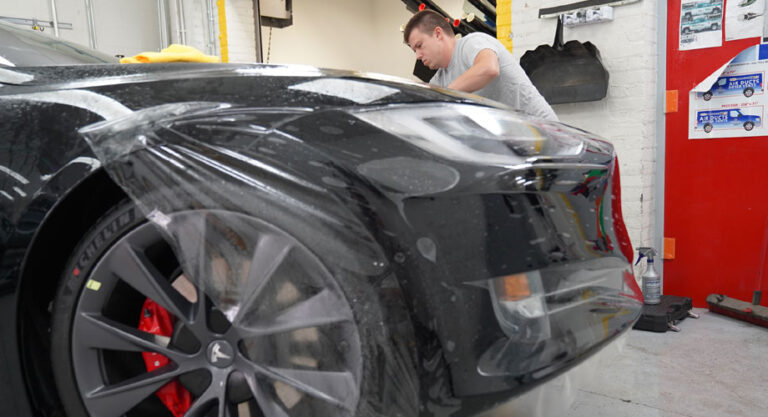
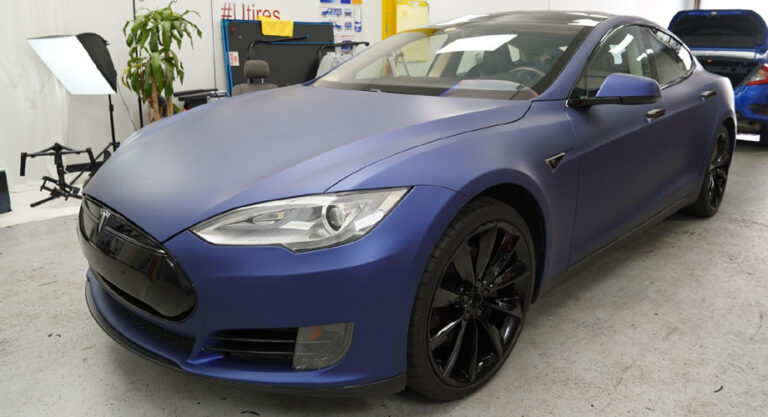




















































































































































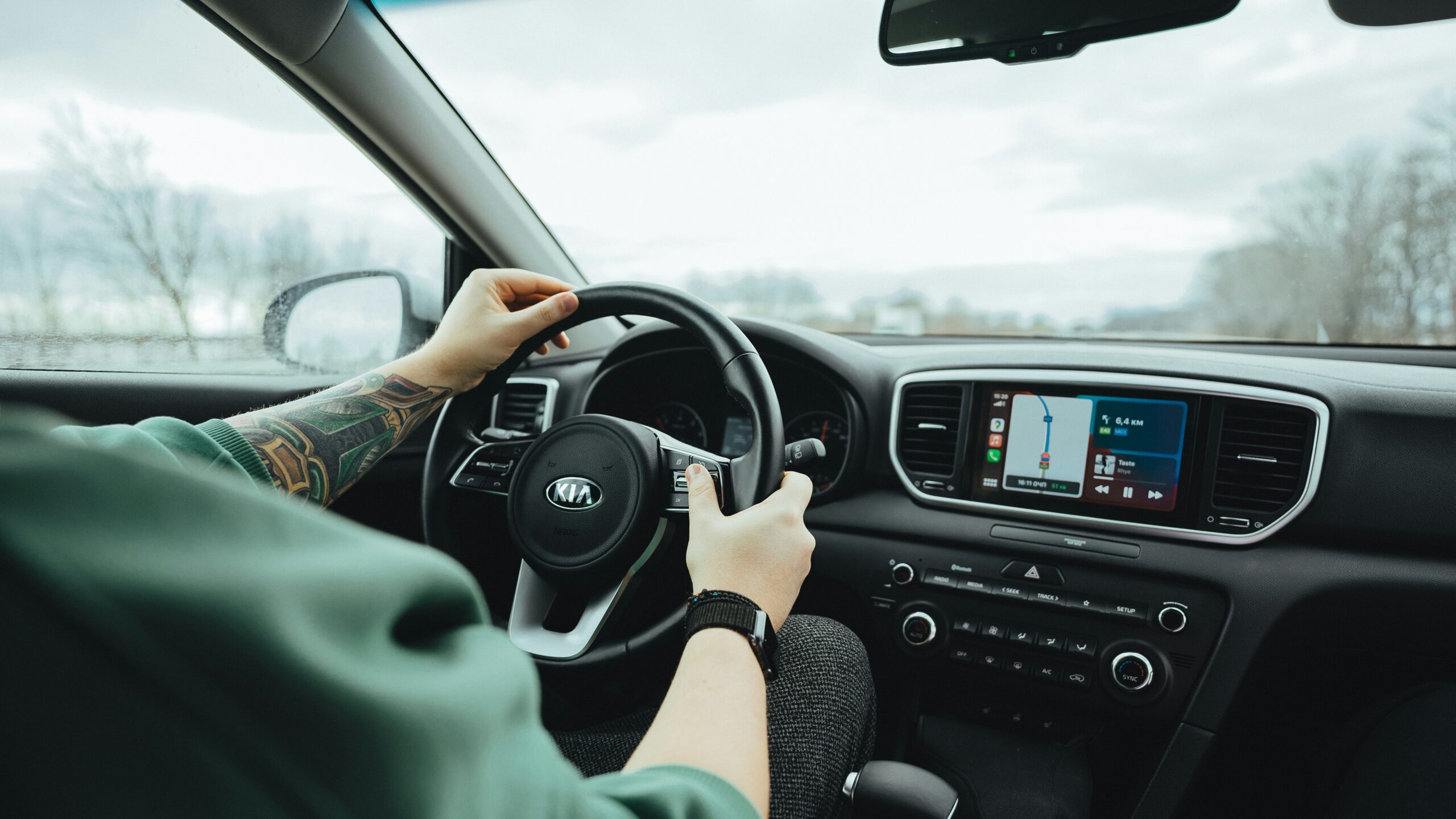
Whether you want to hit the open road on a new adventure or take a quick spin to your mailbox down the street, the choice is yours if you own a vehicle. Many Americans use their cars daily, whether out of necessity or convenience. Even when destinations can be reached with ease by either walking or biking, car owners tend to opt for a short drive with possibly some good tunes.
At Tinting Chicago, we know how valuable a reliable form of transportation is. Many Americans spend a significant amount of their day inside their car commuting to and from places.
However, the length of the commute tends to vary depending on where people live. As leaders in the automotive tinting industry, we were curious to learn more about where Americans frequently take a drive to, specifically short drives that can commonly be thought of as “walking distance.”
To find out, we surveyed drivers in the 30 largest cities in the U.S. about their shortest trips. Read on to find out the top cities where Americans get to their destination before they get through one song on their drivetime playlist and the reasoning behind these short trips.
Key findings
- Almost half, 48%, of Americans have driven 2 minutes or less instead of walking.
- Fort Worth, Las Vegas, and Houston are the top cities where Americans take the shortest drives.
- Americans are least likely to take a short drive in New York City, Washington D.C., and Boston.
- Over 7 in 10 say they drive short distances because they’re lazy.
- Over half, 55%, drive if a destination is 10 minutes or less walking distance, 72% drive if it’s 15 minutes or less.
The U.S. cities where people take the shortest drives
Owning a car is incredibly freeing, and it exempts you from the headache of relying on public transportation schedules or the availability of others to give you a ride. With convenience at their fingertips, it’s no wonder Americans often decide to use their cars to get from point A to point B, regardless of the distance. On top of convenience, many people take pride in their vehicles and love to take them out for a drive without a destination in mind.
When analyzing Americans who take short drives, we found that those who live in Fort Worth, Las Vegas, or Houston are most likely to take a quick spin in their vehicle. With cities known for their high summer temperatures, short drives most likely save these residents from breaking a sweat. While everything may be bigger in Texas, drive time between commutes doesn’t always qualify, as five out of the six cities we analyzed in Texas ranked in the top 10 cities that take the shortest drives.
To determine where people take the shortest drives, we calculated the shortest drive score for each city. We did this by asking respondents a series of questions, including: “How do you typically get to destinations within the following distances?” and “How far away does a destination have to be by walking before you drive instead?” Each response was weighted, and a cumulative score for each respondent was calculated. We then found the average score for each city.
Whether because of easy access to public transportation, a pedestrian-friendly city layout, or lack of ownership of vehicles, taking short trips in some cities is unlikely to happen frequently. Americans are least likely to take a short drive in New York City, Washington D.C., and Boston.
Why Americans drive short distances
Regardless of where you live, there are people using their vehicles to get to distances that are fairly close by either walking or biking. In fact, nearly half of Americans (48%) say they’ve driven 2 minutes or less instead of walking. While driving places can often be timesaving and convenient, for many, getting to places using their car is also just a lazy habit.
Instead of enjoying the fresh air and exercise by walking, 72% of Americans say they drive short distances because they’re lazy. Other reasons are because it’s faster and due to safety concerns. Whatever the reason, hopping in the car for a quick trip is a common part of Americans’ lives.
Although the distance that qualifies as a “short drive” can depend on who you ask, 55% drive if a destination is 10 minutes or less walking distance, and 72% drive if it’s 15 minutes or less. If a destination is only half a mile away, 58% say they still always drive.
Top occasions Americans take a short trip
While the reasoning behind a short trip can vary, there are common occasions where Americans say they opt to drive despite the short duration of the ride. Grabbing food, running an errand, and visiting a friend or family are the top reasons Americans drive short distances. When there’s food or quality time with a loved one at the other end, can we really blame these short-distance drivers for wanting to get to their destination as quickly as possible?
For those traveling within the neighborhood, it’s not because of a lack of safety resources, as 76% of Americans say their neighborhood is pedestrian-friendly. Despite the sidewalks and crosswalks, Americans admit to taking shameless short drives, most frequently within their neighborhood. The top destinations are their mailbox, corner store, and community park.
The short distances Americans drive around town
Short trips don’t just happen within neighborhoods. While out and about, Americans admit to taking short trips while shopping and searching for a parking spot. Whether you want to show off your car’s new auto wrapping by driving around a shopping center to find a close parking spot, or you just want to avoid the walk, you’re not alone.
Over half, 64%, have driven to another store in the same shopping complex they were parked at. The top cities where people drive to another store in the same shopping center are Las Vegas, Fort Worth, and San Antonio. All three of these cities can reach high temperatures in the summer months, so hopping in their car for a quick air break may be much needed.
Whether their destination is far or close, over half of Americans (53%) spin around a short distance once they get there by circling the parking lot looking for a close parking spot to the entrance, rather than accepting an open parking spot farther away. The top cities where people admit to hunting down those close spots are San Francisco, Austin, and Columbus.
How traffic and safety concerns motivate short trips
Although it’s not fun to get stuck in traffic, when you’re sitting down with the A/C on and your favorite playlist jamming through the speakers, some may not consider it as unappealing as walking would be. In fact, 33% say they would rather sit in traffic than get to their destination quicker by walking. The top cities where people would rather take on traffic than get to their destination quicker by walking/biking are Houston, Las Vegas, and Dallas.
Sometimes, taking a short drive has more to do with overall safety than convenience. Whether it’s the time of day or the area you’re venturing out to, walking may not be the smartest option. The top cities where Americans have driven a short distance due to safety concerns are Houston, Memphis, and Philadelphia.
Take short trips in style with Tinting Chicago
Whether you take comfort in hopping in your vehicle for short distances out of safety, convenience, or necessity, you’re not alone. Simply jumping in your car to get to your destination is a big luxury that allows you to have freedom and flexibility.
To add to the luxury, many Americans pride themselves in driving well-maintained cars that have been upgraded for comfort, look, and protection. Regardless of the distance you drive, your car can be susceptible to factors that can damage your precious ride. Whether it’s installing XPEL paint protection or UV protection film to block your interiors from the sun’s harmful rays, our team at Tinting Chicago can upgrade your car’s protection.
With 13 years of experience and a comprehensive range of services offered: Auto Tinting, Auto Wrapping, Car Paint Protection, Residential Tinting, Commercial Tinting, and Commercial Graphics (including fleet graphics), our team is ready to help you with your car’s next upgrade.
Methodology
In April 2024, we surveyed 1,578 Americans in the top 30 U.S. cities about the shortest drives they’ve taken. Respondents ranged in age from 18 to 76 years old and were 49% female, 49% male, and 2% nonbinary.
To determine the shortest drive score, we asked respondents a series of questions, including: “How do you typically get to destinations within the following distances?” and “How far away does a destination have to be by walking before you drive instead?” Each response was weighted, and a cumulative score for each respondent was calculated. We then found the average score for each city.



























